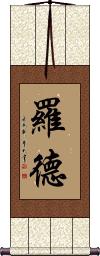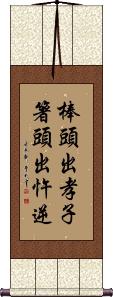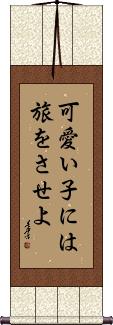Many custom options...
And formats...

The name Rod in Chinese / Japanese...
Buy a Rod calligraphy wall scroll here!
Personalize your custom “Rod” project by clicking the button next to your favorite “Rod” title below...
Spare the Rod, Spoil the Child
棒頭出孝子箸頭出忤逆 literally translates as:
A stick (or switch) produces filial sons; chopsticks produce disobedient [ones].
Figuratively, this means:
Strict discipline produces dutiful children, whereas indulgence produces disobedient ones.
This proverb is very similar to this English proverb:
“Spare the rod and spoil the child.”
If you love your child, send them out into the world
可愛い子には旅をさせよ is a Japanese proverb that means “If you love your children, send them out on a journey into the world.”
This is kind of similar to the western phrase, “Spare the rod and spoil the child.”
More literally, this reads, “Cute child, a journey granted.”
That “granted” could also be understood as “should be initiated.”
Note: Because this selection contains some special Japanese Hiragana characters, it should be written by a Japanese calligrapher.
Bojutsu / Bojitsu
The art of using a stick as a weapon
棒術 is the title Bōjutsu (though some use the romanization Bojitsu).
棒術 is a martial art centered around using a “bō” or staff as a weapon.
This title is a combination of the Japanese word “bō” (which means staff, stick, club, rod, pole, or cudgel) with the Japanese word “jutsu” (which means art or technique).
While this word can be pronounced in Chinese (bang shu), it's not a common term in China. Please consider this title to be “Japanese only.”
These search terms might be related to Rod:
Even an Iron Bar Can Be Ground to a Needle
Have a Walking Stick at the Ready Before You Stumble
Not the results for Rod that you were looking for?
Below are some entries from our dictionary that may match your Rod search...
| Characters If shown, 2nd row is Simp. Chinese |
Pronunciation Romanization |
Simple Dictionary Definition |
可愛い子には旅をさせよ see styles |
kawaiikonihatabiosaseyo / kawaikonihatabiosaseyo かわいいこにはたびをさせよ |
More info & calligraphy: If you love your child, send them out into the world |
幟 帜 see styles |
zhì zhi4 chih noboru のぼる |
flag (1) (kana only) nobori; long, narrow banner attached to a pole on one side and a horizontal rod along the top; (2) (kana only) Boys' Day nobori; carp streamer; (given name) Noboru |
杖 see styles |
zhàng zhang4 chang tsue つえ |
a staff; a rod; cane; walking stick; to flog with a stick (old) cane; walking stick; staff; wand; (surname) Tsuesaki staff |
棍 see styles |
gùn gun4 kun kon こん |
stick; rod; truncheon; scoundrel; villain (rare) (See 棍棒) stick; club |
棒 see styles |
bàng bang4 pang bou / bo ぼう |
stick; club; cudgel; smart; capable; strong; wonderful; classifier for legs of a relay race (1) pole; rod; stick; baton; (2) line; dash; (expression) (3) (net-sl) (See 棒読み・1) spoken monotonously; (surname) Bou A stick, cudgel. |
棹 see styles |
zhuō zhuo1 cho sao さお |
variant of 桌[zhuo1] (1) rod; pole; (2) neck (of a shamisen, etc.); shamisen; (3) beam (i.e. the crossbar of a balance); (4) single line (esp. as a flying formation for geese); (5) (slang) penis; (counter) (6) counter for flags (on poles); counter for long, thin Japanese sweets (e.g. youkan); (surname) Sao pole |
槓 杠 see styles |
gàng gang4 kang kan カン |
coffin-bearing pole (old); thick pole; bar; rod; thick line; to mark with a thick line; to sharpen (a knife, razor etc); to get into a dispute with; standard; criterion; hyphen; dash (noun/participle) {mahj} (See 槓子) forming a four-of-a-kind (chi:); declaring a kong |
籊 see styles |
tì ti4 t`i ti |
long bamboo (for fishing rod) |
綾 绫 see styles |
líng ling2 ling rin りん |
damask; thin silk (1) (kana only) figure; design; (2) twill weave; pattern of diagonal stripes; (3) (kana only) style (of writing); figure (of speech); (4) (kana only) design; plot; plan; (5) (kana only) minor market fluctuation; technical correction; (6) (kana only) (abbreviation) cat's cradle; (7) (kana only) (abbreviation) lease rod (in a loom); (female given name) Rin |
鞭 see styles |
biān bian1 pien muchi むち |
whip or lash; to flog; to whip; conductor's baton; segmented iron weapon (old); penis (of animal, served as food) (out-dated or obsolete kana usage) (1) whip; lash; scourge; (2) stick; cane; rod; pointer; (surname) Muchi |
韃 鞑 see styles |
dá da2 ta muchi むち |
Tartar; a tribe in China (1) whip; lash; scourge; (2) stick; cane; rod; pointer |
ムチ see styles |
muchi ムチ |
(1) whip; lash; scourge; (2) stick; cane; rod; pointer |
ロト see styles |
rodo ロド |
(1) lot; (2) lotto; (personal name) Rod; Rodo |
一竿 see styles |
ikkan いっかん |
one pole (esp. used for fishing poles); one rod; (given name) Ikkan |
刑杖 see styles |
xíng zhàng xing2 zhang4 hsing chang |
rod used for flogging offenders |
划子 see styles |
huá zi hua2 zi5 hua tzu |
rowboat; small boat; oar; paddle; thin rod used to control a curtain etc |
尖棒 see styles |
saibou / saibo さいぼう |
(archaism) rod used to ward off calamities (usu. made of holly olive) |
巡錫 巡锡 see styles |
xún xí xun2 xi2 hsün hsi junshaku じゅんしゃく |
(n,vs,vi) preaching tour To walk about with a metal staff, i. e. to teach. |
探尺 see styles |
tàn chǐ tan4 chi3 t`an ch`ih tan chih |
dipstick; measuring rod |
推桿 推杆 see styles |
tuī gān tui1 gan1 t`ui kan tui kan |
push rod or tappet (mechanics); putter (golf); to putt (golf) |
撮棒 see styles |
saibou / saibo さいぼう |
(archaism) rod used to ward off calamities (usu. made of holly olive) |
散香 see styles |
sàn xiāng san4 xiang1 san hsiang sankō |
disperser's rod |
杆体 see styles |
kantai かんたい |
rod (shape of cell) |
材棒 see styles |
saibou / saibo さいぼう |
(archaism) rod used to ward off calamities (usu. made of holly olive) |
枝鞭 see styles |
edamuchi えだむち |
birch rod |
桿状 see styles |
kanjou / kanjo かんじょう |
(can be adjective with の) rod-shaped; bacillary; bacilliform; baculiform |
桿菌 杆菌 see styles |
gǎn jun gan3 jun1 kan chün kankin かんきん |
bacillus (any rod-shaped bacteria) bacillus |
棍子 see styles |
gùn zi gun4 zi5 kun tzu tsueko つえこ |
stick; rod (female given name) Tsueko |
棍杖 see styles |
gùn zhàng gun4 zhang4 kun chang |
staff; rod |
棒先 see styles |
bousaki / bosaki ぼうさき |
(1) end (of a stick, rod, pole, etc.); (2) end of a palanquin carrying pole; (3) palanquin bearer |
Click here for more Rod results from our dictionary
The following table may be helpful for those studying Chinese or Japanese...
| Title | Characters | Romaji (Romanized Japanese) | Various forms of Romanized Chinese | |
| Rod | ロッド | roddo | ||
| Rod | 羅德 罗德 | luó dé / luo2 de2 / luo de / luode | lo te / lote | |
| Spare the Rod, Spoil the Child | 棒頭出孝子箸頭出忤逆 | bàng tóu chū xiào zǐ zhù tóu chū wǔ nì bang4 tou2 chu1 xiao4 zi3 zhu4 tou2 chu1 wu3 ni4 bang tou chu xiao zi zhu tou chu wu ni | pang t`ou ch`u hsiao tzu chu t`ou ch`u wu ni pang tou chu hsiao tzu chu tou chu wu ni |
|
| If you love your child, send them out into the world | 可愛い子には旅をさせよ | kawaii ko ni wa tabi o sa seyo kawaiikoniwatabiosaseyo kawai ko ni wa tabi o sa seyo | ||
| Bojutsu Bojitsu | 棒術 棒术 | bou jutsu / boujutsu / bo jutsu | bàng shù / bang4 shu4 / bang shu / bangshu | pang shu / pangshu |
| In some entries above you will see that characters have different versions above and below a line. In these cases, the characters above the line are Traditional Chinese, while the ones below are Simplified Chinese. | ||||
Successful Chinese Character and Japanese Kanji calligraphy searches within the last few hours...








